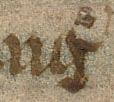|
| A |
 | Usage: abylte
straight-sided 'a' with cross-bar is used throughout. |  | Usage: astirlabye |
 | Usage: haue
there is a hairline stroke at an angle to close the head of the graph. |  | Usage: as |
|
| D |
 | Usage: do
unlooped 'd' is used, with oval bowl and a short, oblique stroke across the head. |  | Usage: and |
 | Usage: condescendyt |  | Usage: vnd(er)stand
the scribe's abbreviations are all neatly executed. Here the comma-like mark with tail stands for the 'er' abbreviation. |
|
| G |
 | Usage: mygth
'g' is tailed and is often open at the head. |  | Usage: towching
'g' in final position with a mark similar to the 'er' abbreviation, here probably representative of a missing 'e'. |
 | Usage: rygthful |  | Usage: begynneth
'g' in the incipit. The scribe's script for the incipit is the same as his normal hand. |
|
| H |
 | Usage: haue
the stem of 'h' sometimes has a kink as well as a defined foot. The limb descends from the shoulder also with a kink in the stroke. |  | Usage: him
sometimes the head of the stem is split. |
 | Usage: wrappith |  | Usage: philosophir
the limb has a kink and ends with a fine extension at right angles to the descender. |
|
| R |
 | Usage: rygthful
modern 'r' is used in all positions excep after 'o'. |  | Usage: preyer
in final position the same flourish mark above the 'r' may represent a missing 'e'. |
 | Usage: p(ro)porcons
'z'-shaped 'r' after 'o'. |  | Usage: oure |
|
| S |
 | Usage: same
straight 's' with separate stroke for the angled head and slight serif to the left of the stem. Used in initial and medial positions. |  | Usage: as
kidney-shaped 's' used in final position. |
 | Usage: (con)clusions |  | Usage: lewes
final 's' which could almost be '8'-shaped at times. |
|
| W |
 | Usage: wel
'w' varies little. Both arms are almost straight with slight curve to the left. There is a 'B'-shaped element to the right, also neatly executed. |  | Usage: whyche |
 | Usage: wrappith |  | Usage: towching |
|
| Y |
 | Usage: thyne
'y' is frequently dotted. The tail is often almost non-existent. |  | Usage: p(ra)yere |
 | Usage: astirlabye |  | Usage: tretyyce |
|
| Thorn |
 | Usage: þe
thorn only appears to be used in the very short pronoun or article situations. |  | Usage: þat |
 | Usage: þt(supserscript)
the head of thorn is frequently left open. |  | Usage: þi
the stem of thorn is thick and does not taper. |






































